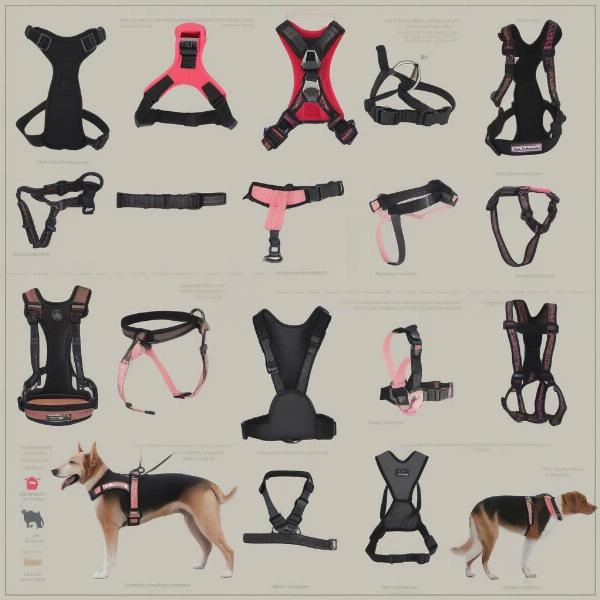A harness for old dogs can significantly improve their quality of life, offering support and stability during walks and other activities. As dogs age, they may experience mobility issues, arthritis, or general weakness, making a traditional collar uncomfortable or even painful. A harness distributes pressure more evenly across their body, reducing strain on their neck and joints. Choosing the right harness for your senior dog is a crucial decision that can enhance their comfort and safety.
Why Consider a Harness for Older Dogs?
As our canine companions enter their golden years, they often experience physical changes that can make walks challenging. Arthritis, hip dysplasia, and muscle weakness are common ailments that can affect their mobility. A harness provides much-needed support, helping them maintain balance and reducing the risk of falls. Unlike collars, which can put pressure on the delicate trachea and neck, harnesses distribute pressure across the chest and back, minimizing discomfort and potential injury. A harness can also make it easier for you to assist your senior dog when navigating stairs or uneven terrain.
Choosing the Right Harness: Features to Look For
 Different types of harnesses for senior dogs
Different types of harnesses for senior dogs
Selecting the perfect harness for your elderly dog involves considering their specific needs and physical condition. Look for harnesses with ample padding for added comfort, especially around the chest and shoulders. Adjustability is key to ensure a snug but not restrictive fit. Easy-on/easy-off designs, such as step-in harnesses, are particularly beneficial for dogs with limited mobility or arthritis. For dogs with significant weakness in their hind legs, a lifting harness can provide support and assistance. Consider a dog harness for older dogs specifically designed for senior dogs.
Different Types of Harnesses for Senior Dogs
Front-Clip Harnesses
Front-clip harnesses are helpful for dogs who tend to pull, as they gently redirect their forward momentum. This can be particularly beneficial for older dogs who may be more prone to pulling due to decreased vision or cognitive decline.
Back-Clip Harnesses
Back-clip harnesses are a good option for dogs who walk calmly on a leash. They provide comfortable support without restricting their natural gait. A yellow harness dog is easily visible, adding an extra layer of safety during walks.
Step-In Harnesses
Step-in harnesses are ideal for senior dogs with limited mobility, as they simply step into the harness and it fastens around their back. This eliminates the need to lift their legs or contort their bodies.
Lift Harnesses
Lift harnesses provide support for the hind legs and abdomen, making it easier for you to assist your senior dog with standing, walking, and navigating stairs. This is particularly helpful for dogs with arthritis, hip dysplasia, or other mobility issues.
Getting the Right Fit: Measuring Your Dog
Ensure a proper fit by measuring your dog’s chest girth and consulting the manufacturer’s sizing chart. A well-fitted harness should be snug but not restrictive, allowing for two fingers to fit comfortably between the harness and your dog’s body.
Conclusion
Investing in a harness for your older dog is a simple yet effective way to improve their comfort, mobility, and overall quality of life. Choosing the right harness can make walks more enjoyable for both you and your furry friend, allowing you to cherish your time together in their golden years. Remember to consider their individual needs and choose a harness that provides the appropriate level of support and comfort. A dog eyeglass holder could be a useful additional accessory for your needs.
FAQ
-
What type of harness is best for a senior dog with arthritis? A padded harness, either a step-in or lift harness, is generally best for senior dogs with arthritis.
-
How do I measure my dog for a harness? Measure the circumference of your dog’s chest, just behind their front legs, and refer to the manufacturer’s sizing chart.
-
Can a harness help my senior dog with mobility issues? Yes, a harness can provide support and stability, making it easier for senior dogs with mobility issues to walk and maintain balance.
-
Are front-clip harnesses better than back-clip harnesses for older dogs? It depends on the individual dog. Front-clip harnesses are good for dogs who pull, while back-clip harnesses are suitable for calm walkers.
-
How do I clean my dog’s harness? Most harnesses can be hand washed or machine washed on a gentle cycle. Always check the manufacturer’s instructions.
-
What is a lifting harness? A lifting harness provides support for the hind legs and abdomen, assisting dogs with weakness or mobility issues. An elderly dog harness can also offer support.
About ILM Dog
ILM Dog is your trusted resource for expert advice on all aspects of dog care and wellbeing, from breed selection and puppy care to senior dog health and product recommendations. We offer practical tips and insights on nutrition, training, grooming, and much more to help you provide the best possible care for your canine companion. We also provide advice on helpful items such as an rv screen door protector for dogs. For personalized guidance on finding the perfect harness for your senior dog, contact us at [email protected] or call us at +44 20-3965-8624.